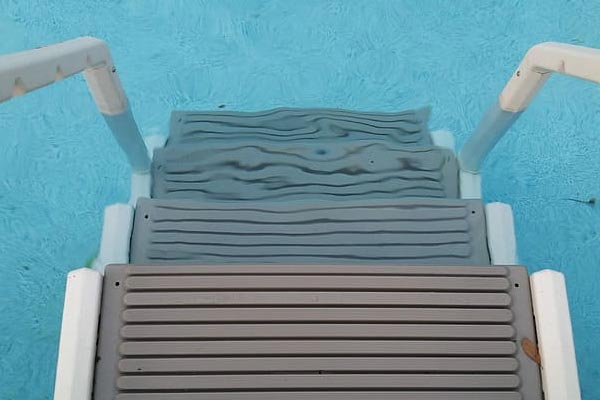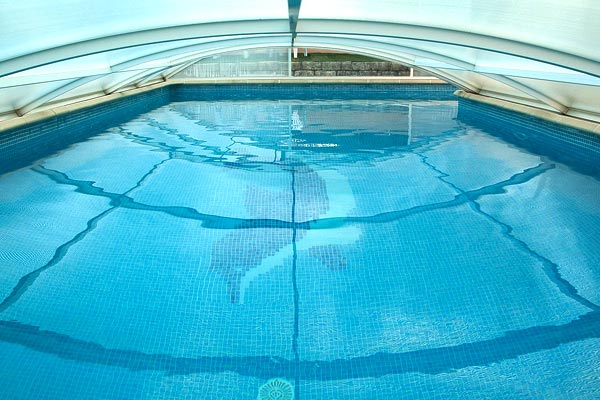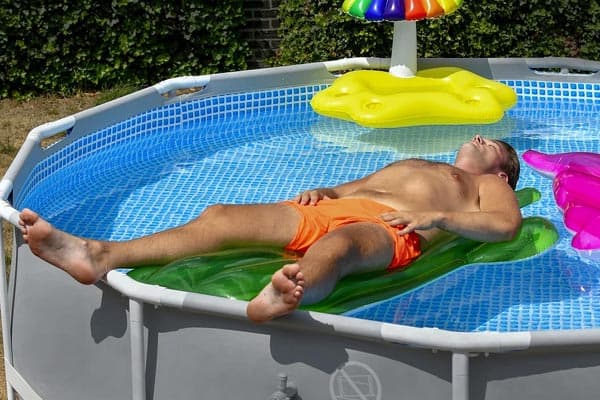What to Put Under an Above-Ground Pool – Several Options
You’ve decided that you want to put an above-ground pool in your backyard, so now you have to figure out how to install it.
You could put the pool right on top of the grass, but this isn’t the best idea because having a stable base under the pool is critical.
You have your spot picked out, removed the grass, and leveled the ground where you want the pool to sit, now what?
What to Put Under Above-Ground Pool
One of the best materials to put under your new above-ground pool is a Gorilla Pad or an Armor shield because these products feature materials that are breathable enough to allow moisture through while being very tough. No matter if you’re installing a pool on a sand base and cove, foam cove, liner floor pad, concrete, or more, all of them have benefits and drawbacks.
If you’re wondering what to put under an above-ground pool because you don’t want to sit it directly on the grass, this is for you.
We’re going to outline several options you have available, and you can decide which ones work best for your situation.
Sand Base and Sand Cover Installation
The first thing you have to do is get fine sand that is free of debris and rocks, and you’ll lay a three-inch-thick bed of sand across the entire inside of the pool to form the base.
Next, build a sand cover against the pool by creating a four-inch angle of sand on top of the original three inches to make your total sand cover height seven inches when the base meets your pool wall.
The goal is to completely support the vinyl pool liner by the pool base to avoid damage.
Sand Base and Foam Cove
Get fine sand free of rocks and debris once again and layout a three-inch-thick bed across the entire inside of the pool to create your base.
Once you get this base in, you’ll attach a foam pool cove by removing the adhesive cover from the backing and sticking it to the metal pool right on top of the sand where the metal pool wall and base meet.
You’ll support the vinyl pool liner with this base to avoid any damage to your metal pool wall.
Sand Base, Foam Cover, and Liner Floor Pad
Lay down your three-inch thick layer of sand without any debris or rocks across the entire pool to form the base and lay the liner floor pad on top.
The liner floor pad will come cut to fit your pool’s dimensions, and you want to attach the foam pool cove directly on top of your liner floor pad by pulling the adhesive off and sticking it to your metal pool wall.
Potential Things You Can Put Under Your Pool
There are a few things you can put under your pool if you don’t want to have a sand base because you don’t think that it’s going to support your pool long-term. We’re going to highlight six popular options you have available below.
Concrete
Concrete pads are a good choice to use as a base for your pool, but you’ll want to have another layer between the two of them.
Concrete will wear on the pool liner because it’s abrasive, so you don’t want it in direct contact. Concrete is perfectly flat and stable, so it forms a solid base that won’t let the pool shift over time.
To install it, start by marking the area one foot larger than your pool and removing any debris and grass from the area.
Add in filler to get a smooth surface, treat the area with weed killer to get rid of aggressive weeds, and raise the area that the pool sits on slightly above the natural ground line to allow the water to drain from your pool.
Next, you’ll lay your pool and fill in the extra foot of space around it with a landscaping material like pea gravel. Pull any weeds out that start to grow in the space to make it look neat and clean.
Pros:
- Perfectly flat and stable
- Won’t allow for pool shifting
- Easy to tailor to pool size and shape
Cons:
- Requires a second padding layer
- Abrasive
- Will wear the liner
Commercial Pads
Commercial pads are a nice thing to place between a concrete pad and the pool liner to protect it, and you can buy them pre-cut to most standard sizes.
You can also cut to the exact measurements while using the pool walls as a guide, and they’re tough enough to stand up to different elements.
They’re breathable and won’t allow moisture to get trapped under the pool, but they’re also expensive.
When you install it, you’ll want to put two layers down since they’re thin, and you want to make sure to clear out any sharp debris or objects before you install it to prevent damaging it.
Pros:
- Breathable and tough
- Can cut it to your pool’s exact measurements
- Standard sizes come pre-cut
Cons:
- Expensive choice
- Need two per pool because they’re thin
Solid Foam
Putting solid foam on the concrete is a nice choice, but it can be a more expensive one.
Foam comes in a large range of thicknesses, and using one thick layer is better than using a lot of thin layers because there is less of a chance of it sliding around.
You want to cut it to the correct size before you lay it down, and it can be challenging to cut down to size.
The thicker your foam is, the harder it will be for you to slice through cleanly. You should make sure your foam is for outdoor use, and you can use the pool walls as a guide to cut the exact size and shape you need.
Install the padding directly on the concrete inside your pool walls, and put the liner on top of your foam.
Pros:
- Won’t slide around on the concrete
- Comes in several thicknesses
- Only need one thicker layer
Cons:
- Can be an expensive option
- Challenging to cut
Sand
A lot of people choose to use sand as the base for their pool because it’s easy to lay and inexpensive, but you can’t use it with concrete.
Sand also has stability issues because it uses tiny particles that can shift around and make your pool move, and many burrowing insects like to burrow under your pool and make weak spots.
You want to remove all debris and sharp objects from the area before making the top surface of your sand layer slightly higher than the ground level.
Fill in any weak spots, level them, and rake them smooth before you install the pool over them.
Pros:
- Easy and quick to install
- Inexpensive
Cons:
- Insects can burrow and create weak spots
- Sand can shift
- Can’t use it with a concrete base
Flooring Underlayment
Flooring underlayment is one of the most common and budget-friendly options you can put on your concrete slab to help shield your liner from the concrete’s surface.
It’s very thin though, so it offers a very small cushion. You’ll have to put down several layers of underlayment to create a softer surface.
You’ll have to cut the flooring underlayment to size using the pool walls to guide you on the shape and dimensions before you lay it out.
You will have to cut and size multiple layers to create a decent amount of cushion for your pool.
Pros:
- Shields the liner from abrasive concrete
- Inexpensive option
Cons:
- Offers minimal cushion
Carpet Padding
Carpet padding is another common option a lot of people choose to use under their pool as an above-ground pool liner because it’s inexpensive, readily available, and you know how to use it.
Carpet padding isn’t usually very thick though, so you’ll have to put at least two layers down to create a softer cushion.
When you install your carpet padding, you want to use a dense foam material instead of rubber or felt fiber.
Memory foam is a good choice, too, because it’ll conform to the pool’s shape while providing support. The pool walls will guide your cutting to ensure it fits well.
Pros:
- Highly available
- Economical choice
Cons:
- Might need more than one layer
- Doesn’t offer a lot of cushions
Our Top Recommendations
We didn’t cover every material you could use to put under your above-ground pool during the installation process, so you have to decide which one is best for you.
You should remember that if water can get through it, it can eventually corrode. If the material you pick out has petroleum in it, it will react to the vinyl to ruin the pool liner.
If it has holes, it’ll allow pests or grass to pass through it and cause spots under your pool.
Consider using a commercial-grade product like Armor Shield or Gorilla Pad to get the padding off the ground and protected by a thin layer of tough, durable material. All of these things will help it last much longer and reduce your overall maintenance.
Bottom Line
There are several materials you can use for your above-ground pool liner, and we’ve outlined a few different options for you to help you make your final choice.
Look at them, make a quick comparison, and see which one makes the most sense for your needs.






